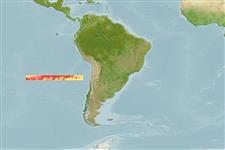Environment: milieu / climate zone / depth range / distribution range
Écologie
marin démersal. Subtropical; 25°S - 28°S, 110°W - 76°W (Ref. 89357)
Southeast Pacific: Easter I. and Desventuradas Is. (Ref. 89357).
Taille / Poids / Âge
Maturity: Lm ? range ? - ? cm
Max length : 76.4 cm TL mâle / non sexé; (Ref. 28618)
Description synthétique
Clés d'identification | Morphologie | Morphométrie
Light yellowish-gray background with irregularly-placed roundish dark blotches. Visible, small black dots of lateral line pores around and behind head.
Type specimen taken from a depth of 250 m (Ref. 33021).
Life cycle and mating behavior
Maturities | Reproduction | Spawnings | Egg(s) | Fecundities | Larves
Pequeño, G., 1989. Peces de Chile. Lista sistematica revisada y comentada. Rev. Biol. Mar., Valparaiso 24(2):1-132. (Ref. 9068)
Statut dans la liste rouge de l'IUCN (Ref. 130435)
Menace pour l'homme
Harmless
Utilisations par l'homme
Pêcheries: intérêt commercial mineur
Outils
Articles particuliers
Télécharger en XML
Sources Internet
Estimates based on models
Phylogenetic diversity index (Ref.
82804): PD
50 = 0.5000 [Uniqueness, from 0.5 = low to 2.0 = high].
Bayesian length-weight: a=0.00047 (0.00025 - 0.00089), b=3.28 (3.13 - 3.43), in cm total length, based on LWR estimates for this Genus-body shape (Ref.
93245).
Niveau trophique (Ref.
69278): 4.0 ±0.6 se; based on size and trophs of closest relatives
Résilience (Ref.
120179): Faible, temps minimum de doublement de population : 4,5 à 14 années (Preliminary K or Fecundity.).
Fishing Vulnerability (Ref.
59153): Moderate to high vulnerability (51 of 100).
